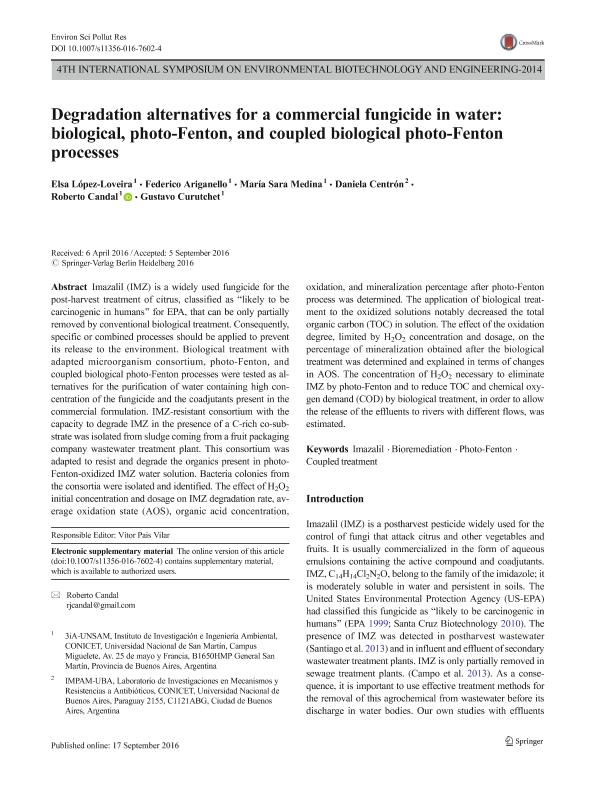Mostrar el registro sencillo del ítem
dc.contributor.author
Lopez Loveira, Elsa Gabriela

dc.contributor.author
Ariganello, Federico

dc.contributor.author
Medina, Maria Sara

dc.contributor.author
Centron, Daniela

dc.contributor.author
Candal, Roberto Jorge

dc.contributor.author
Curutchet, Gustavo Andres

dc.date.available
2018-05-30T17:35:24Z
dc.date.issued
2017-11
dc.identifier.citation
Lopez Loveira, Elsa Gabriela; Ariganello, Federico; Medina, Maria Sara; Centron, Daniela; Candal, Roberto Jorge; et al.; Degradation alternatives for a commercial fungicide in water: biological, photo-Fenton, and coupled biological photo-Fenton processes; Springer Heidelberg; Environmental Science and Pollution Research; 24; 33; 11-2017; 25634-25644
dc.identifier.issn
0944-1344
dc.identifier.uri
http://hdl.handle.net/11336/46665
dc.description.abstract
Imazalil (IMZ) is a widely used fungicide for the post-harvest treatment of citrus, classified as “likely to be carcinogenic in humans” for EPA, that can be only partially removed by conventional biological treatment. Consequently, specific or combined processes should be applied to prevent its release to the environment. Biological treatment with adapted microorganism consortium, photo-Fenton, and coupled biological photo-Fenton processes were tested as alternatives for the purification of water containing high concentration of the fungicide and the coadjutants present in the commercial formulation. IMZ-resistant consortium with the capacity to degrade IMZ in the presence of a C-rich co-substrate was isolated from sludge coming from a fruit packaging company wastewater treatment plant. This consortium was adapted to resist and degrade the organics present in photo-Fenton-oxidized IMZ water solution. Bacteria colonies from the consortia were isolated and identified. The effect of H2O2 initial concentration and dosage on IMZ degradation rate, average oxidation state (AOS), organic acid concentration, oxidation, and mineralization percentage after photo-Fenton process was determined. The application of biological treatment to the oxidized solutions notably decreased the total organic carbon (TOC) in solution. The effect of the oxidation degree, limited by H2O2 concentration and dosage, on the percentage of mineralization obtained after the biological treatment was determined and explained in terms of changes in AOS. The concentration of H2O2 necessary to eliminate IMZ by photo-Fenton and to reduce TOC and chemical oxygen demand (COD) by biological treatment, in order to allow the release of the effluents to rivers with different flows, was estimated.
dc.format
application/pdf
dc.language.iso
eng
dc.publisher
Springer Heidelberg

dc.rights
info:eu-repo/semantics/openAccess
dc.rights.uri
https://creativecommons.org/licenses/by-nc-sa/2.5/ar/
dc.subject
Imazalil
dc.subject
Bioremediation
dc.subject
Photo-Fenton
dc.subject
Coupled Treatment
dc.subject.classification
Ingeniería Medioambiental y Geológica, Geotécnicas

dc.subject.classification
Ingeniería del Medio Ambiente

dc.subject.classification
INGENIERÍAS Y TECNOLOGÍAS

dc.title
Degradation alternatives for a commercial fungicide in water: biological, photo-Fenton, and coupled biological photo-Fenton processes
dc.type
info:eu-repo/semantics/article
dc.type
info:ar-repo/semantics/artículo
dc.type
info:eu-repo/semantics/publishedVersion
dc.date.updated
2018-05-29T18:35:38Z
dc.journal.volume
24
dc.journal.number
33
dc.journal.pagination
25634-25644
dc.journal.pais
Alemania

dc.journal.ciudad
Heildelberg
dc.description.fil
Fil: Lopez Loveira, Elsa Gabriela. Consejo Nacional de Investigaciones Científicas y Técnicas; Argentina. Universidad Nacional de San Martín. Escuela de Ciencia y Tecnología; Argentina
dc.description.fil
Fil: Ariganello, Federico. Consejo Nacional de Investigaciones Científicas y Técnicas; Argentina. Universidad Nacional de San Martín. Escuela de Ciencia y Tecnología; Argentina
dc.description.fil
Fil: Medina, Maria Sara. Consejo Nacional de Investigaciones Científicas y Técnicas; Argentina. Universidad Nacional de San Martín. Escuela de Ciencia y Tecnología; Argentina
dc.description.fil
Fil: Centron, Daniela. Consejo Nacional de Investigaciones Científicas y Técnicas. Oficina de Coordinación Administrativa Houssay. Instituto de Investigaciones en Microbiología y Parasitología Médica. Universidad de Buenos Aires. Facultad de Medicina. Instituto de Investigaciones en Microbiología y Parasitología Médica; Argentina
dc.description.fil
Fil: Candal, Roberto Jorge. Consejo Nacional de Investigaciones Científicas y Técnicas; Argentina. Universidad Nacional de San Martín. Escuela de Ciencia y Tecnología; Argentina
dc.description.fil
Fil: Curutchet, Gustavo Andres. Consejo Nacional de Investigaciones Científicas y Técnicas; Argentina. Universidad Nacional de San Martín. Escuela de Ciencia y Tecnología; Argentina
dc.journal.title
Environmental Science and Pollution Research

dc.relation.alternativeid
info:eu-repo/semantics/altIdentifier/doi/https://dx.doi.org/10.1007/s11356-016-7602-4
dc.relation.alternativeid
info:eu-repo/semantics/altIdentifier/url/https://link.springer.com/article/10.1007%2Fs11356-016-7602-4
Archivos asociados
